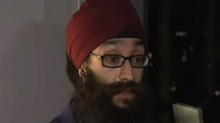Columbia University Professor, a Sikh Physician, Injured in Teen Mob Attack
Shortly after a white supremacist stormed into a Sikh temple in Wisconsin and killed six worshipers last year, Dr. Prabhjot Singh, a Sikh-American physician and assistant professor of international affairs at Columbia University, co-wrote a column for The New York Times noting the “long history of discrimination and hatred directed at Sikhs in America.”
On Saturday night, on the edge of Harlem, Singh became a victim of the hatred and violence.
As he strolled down the street with a friend near 110th and Lenox at about 8 p.m., a band of up to 20 teenagers on bicycles surrounded Singh, shouting “terrorist” and “get Osama.”
Then, according to the Daily News and the Sikh Coalition, the teens began punching and kicking Singh, who wears a turban and beard in adherence to his Sikh faith. As Singh tried to escape, the teenagers chased him down the street, throwing punches and slurs, apparently mistaking him for a Muslim.
Singh, according to the Sikh Coalition, suffered displaced teeth, severe bruising and swelling, a small puncture in his elbow and a possible fracture in his lower jaw. “It could have been worse,” Amardeep Singh, program director for the Sikh Coalition, a civil rights advocacy group based in New York, told Hatewatch today. “Luckily, there were a lot of people of good will, who intervened.”
Amardeep Singh said several passersby physically tried to intervene, while others yelled at the teenagers that they had called the police.
Singh was taken by ambulance to Mt. Sinai hospital, where he is a resident physician. He was treated and released. He was scheduled to give a news conference in New York this afternoon.
The band of teenagers was reported to be mostly black, but Amardeep Singh said that both the Sikh Coalition and “the victim” – Dr. Singh – declined to answer questions about the race of the attackers.
“It’s not helpful,” Amardeep Singh told Hatewatch. “We don’t think it’s helpful in reducing racial tensions. We’re trying to get the country to live up to its best values. We’re a community that is profiled. There’s no reason for us to profile anyone.”
He said, for that reason, Dr. Singh was reluctant to cooperate with police sketch artists.
“There’s no real identifiable information,” Amardeep Singh said. “It was a sudden and intense attack. He was just trying to make sure he wasn’t injured further.”
“Race is not relevant,” he said. “What is relevant is for whatever reason they had hate in their hearts and acted on it.”
In a press release about the attack on Dr. Singh, the Sikh Coalition said the incident came less than two weeks after the first-ever nationwide public perception assessment of Sikh Americans, titled “Turban Myths.” That survey shows that 70 percent of Americans misidentify turban-wearers – like Dr. Singh – in the U.S. as Muslim, Hindu, Buddhist or Shinto. Nearly all turban-wearers in the U.S. adhere to Sikhism.
“What happened” on Saturday night, Amardeep Singh said in the Coalition statement, “did not happen in a vacuum. Here in New York City we regularly receive reports that Sikh schoolchildren are called ‘Bin Laden’ or ‘terrorist’ by classmates and sometimes endure physical violence.”
And when they grow up to be professors and physicians, the violence still follows them down the street.


